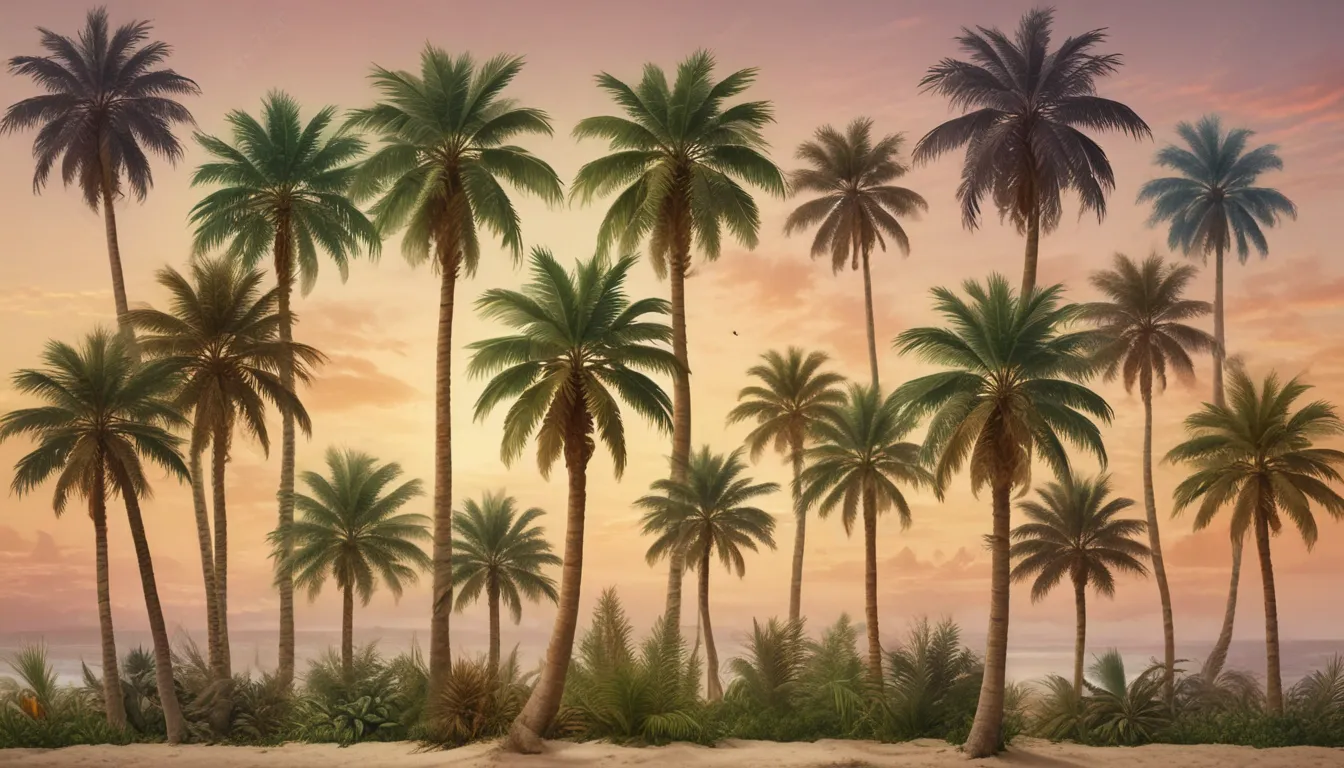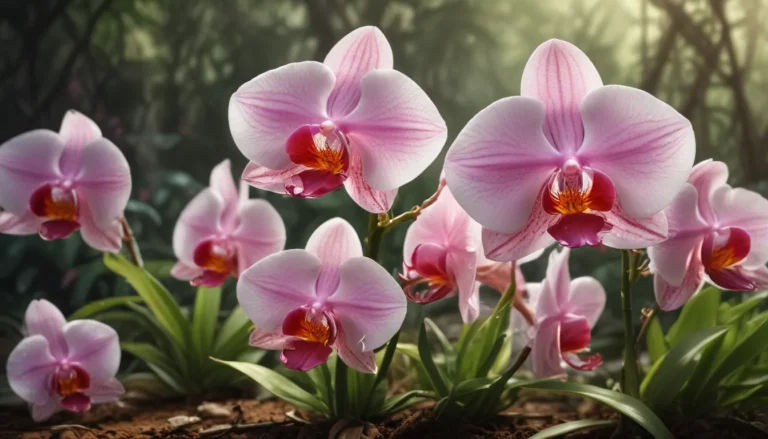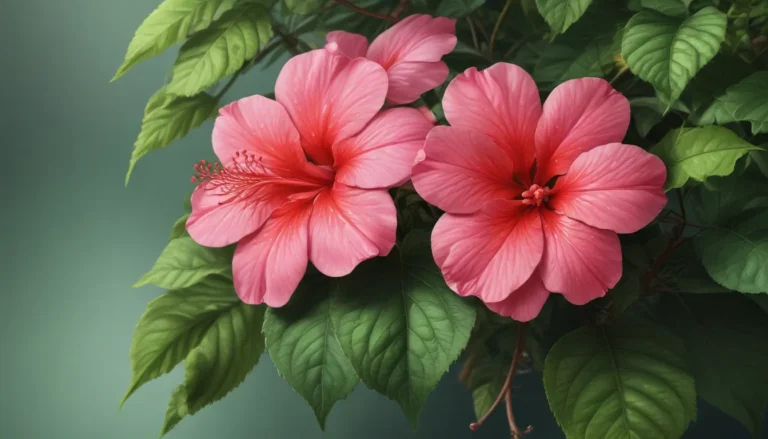The pictures we use in our articles might not show exactly what the words say. We choose these pictures to make you interested in reading more. The pictures work together with the words but don’t take their place. The words still tell you the important facts.
Palm trees are more than just tropical flora; they are a symbol of life, resilience, and beauty. With over 2,500 different types of palm trees worldwide, each variety offers unique features and benefits to its ecosystem. From the majestic Quindio wax palms of Colombia to the resilient hurricane palms of Africa, palm trees play a vital role in our environment and culture. Let's delve deeper into the origins, characteristics, and uses of some of the most fascinating palm tree varieties from around the globe.
Origins of Palm Trees
Palm trees have a rich history that dates back millions of years, with fossil records revealing their presence 56 million years ago. Archaeologists have found evidence of ancient civilizations utilizing palm trees for food, shelter, and livelihood. The Assyrians, known for cultivating date palms in Northern Iraq, revered these trees for their religious and practical significance. In various cultures, palm trees symbolize peace, prosperity, and vitality, making them a cherished resource for communities worldwide.
Types of Palm Trees By Region
From the bustling streets of California to the remote islands of Fiji, palm trees thrive in diverse climates and landscapes globally. Let's explore a selection of unique palm tree varieties from different regions and uncover their distinctive features and uses.
Sabal Palm
Native to Florida, the sabal palm, also known as the cabbage palm, is a popular choice for its resilience and versatility. These palms are prized for their ability to withstand hurricanes, floods, and fires, making them a favorite among homeowners and landscapers. The sabal palm's fruits are edible and sought after for their sweet taste, while its leaves and trunks have been used by indigenous tribes for shelter and crafts.
Roystonea Regia
The Roystonea regia, or Cuban royal palm, is a majestic palm tree native to Florida, Central America, Mexico, and the Caribbean. Renowned for its towering height and elegant appearance, the Roystonea regia holds cultural significance in regions where it is grown. From religious ceremonies to ornamental plantings, this palm tree plays a vital role in local traditions and practices.
California Fan Palms
The California fan palm, also known as the desert fan palm, is a cherished symbol of California's unique landscape. With its distinctive fan-shaped leaves and ability to thrive in arid conditions, this palm tree is a favorite choice for gardens and urban environments. Wildlife, such as orioles and frogs, rely on the California fan palm for shelter and sustenance, highlighting its ecological importance in the desert ecosystem.
Needle Palmetto
The Needle Palmetto, with its sharp leaves and robust form, is a hardy palm tree native to the southeastern United States. Resilient to low temperatures and requiring minimal maintenance, the Needle Palmetto is a popular choice for coastal regions seeking a touch of tropical elegance. However, overharvesting and illegal trade pose a threat to wild populations of this unique palm tree.
Quindio Wax Palms
Standing tall in the Andean mountains of Colombia, the Quindio wax palms are renowned for their impressive height and resilience to extreme altitudes. Declared the national tree of Colombia, these majestic palms play a crucial role in the local ecosystem and culture. Despite their rarity and endangered status, efforts to protect and preserve the Quindio wax palms are underway to ensure their survival for generations to come.
Types of Palm Trees in Africa
Africa is home to a diverse array of palm tree species that are essential for wildlife, ecosystems, and local communities. From the African oil palm to the hurricane palm, these trees provide food, shelter, and livelihoods for many across the continent.
African Oil Palm
The African oil palm, with its oily seeds and versatile uses, is a key source of food, industry, and medicine in Africa. From palm oil production to skincare products, this palm tree plays a vital role in various sectors of the economy. However, the expansion of oil palm plantations has led to environmental concerns, including deforestation and habitat loss, highlighting the need for sustainable practices in palm oil production.
Hurricane Palm
The hurricane palm, known for its resistance to strong winds and tropical storms, is a valuable asset in coastal regions of Africa. Its unique features, including male and female flowers and ovoid fruits, make it a sought-after ornamental tree for gardens and urban landscapes. Despite its popularity, efforts to protect the natural habitats of the hurricane palm are essential to preserve its genetic diversity and ecosystem health.
Lodoicea Maldivica
The Lodoicea Maldivica, or coco-de-mer, is a rare and prized palm tree native to the Seychelles islands. Known for producing the largest seed in the plant kingdom, the coco-de-mer has cultural, economic, and ecological significance in the region. From traditional uses in art and cuisine to modern conservation efforts, the coco-de-mer exemplifies the delicate balance between human activities and natural resources.
Blue Latan Palm
The blue latan palm, with its silvery-blue leaves and striking appearance, is a popular choice for landscaping and decor in Africa. Native to Mauritius, this palm tree thrives in sunny climates and well-drained soil, making it an ideal choice for gardens and public spaces. However, challenges such as lethal yellowing disease and habitat loss threaten the survival of the blue latan palm, underscoring the importance of conservation efforts.
Majesty Palm
The majestic palm, prized for its graceful fronds and elegant form, is a rare and endangered species native to Madagascar. With limited populations remaining in the wild, efforts to protect and conserve the majestic palm are essential to ensure its survival for future generations. Cultivated for its ornamental beauty, the majestic palm faces challenges from habitat destruction and climate change, highlighting the need for sustainable practices in palm tree conservation.
Types of Palm Trees in Asia
Asia, with its diverse landscapes and climates, is home to a wide range of palm tree species that are valued for their beauty, cultural significance, and economic importance. From the Chinese fan palm to the Asian palmyra palm, these trees play a vital role in ecosystems and communities across the continent.
Livistona Chinensis
The Chinese fan palm, also known as Livistona chinensis, is a popular ornamental palm tree that adorns gardens and landscapes in Asia. With its unique fan-shaped leaves and adaptability to various climates, the Chinese fan palm is a favorite choice for urban environments and private residences. However, its rapid growth and invasive potential pose challenges to local ecosystems, highlighting the need for responsible cultivation and management of this palm tree species.
Asian Palmyra Palm
The Asian palmyra palm, also known as the toddy palm, is a versatile and valuable palm tree species in Asia. From food production to religious practices, the Asian palmyra palm plays a significant role in the cultural and economic life of communities across the region. With its edible fruits, sap, and fibers, this palm tree offers a wide range of benefits that contribute to livelihoods and traditions in Asia.
Nipa Palm
The nipa palm, with its unique adaptation to mangrove ecosystems, is a vital resource for coastal communities in Asia. From building materials to food sources, the nipa palm provides essential goods and services that support livelihoods and biodiversity in these fragile environments. Efforts to protect and conserve nipa palm habitats are crucial to ensure the survival of this valuable palm tree species for future generations.
Chinese Windmill Palm
The Chinese windmill palm, also known as Trachycarpus fortunei, is a cold-hardy palm tree native to China and Japan. With its wind-resistant characteristics and lush foliage, the Chinese windmill palm is a popular choice for gardeners and landscapers in both Asia and Europe. However, challenges such as inedible fruits and susceptibility to diseases highlight the importance of careful cultivation and management of this unique palm tree species.
Date Palm
The date palm, one of the oldest palm tree species in the world, is prized for its sweet fruits and versatile uses. From food production to furniture making, the date palm offers a wide range of products and services that benefit communities across Asia and the Middle East. With its economic value and cultural significance, the date palm remains a valuable resource for livelihoods and traditions in the region.
Types of Palm Trees in Oceania
Oceania, with its diverse islands and ecosystems, is home to a rich variety of palm tree species that are essential for biodiversity, culture, and sustainability. From the nikau palm of New Zealand to the Molokai fan palm of Hawaii, these trees play a vital role in maintaining healthy ecosystems and supporting local communities.
Nikau Palm Tree
The nikau palm tree, native to New Zealand, is a cherished symbol of the country's unique flora and fauna. With its distinctive fronds and versatile uses, the nikau palm offers a wide range of benefits for wildlife and ecosystems in New Zealand. From traditional practices to modern conservation efforts, the nikau palm plays a crucial role in preserving biodiversity and cultural heritage in the region.
Fiji Fan Palm
The Fiji fan palm, also known as Pritchardia pacifica, is a beloved palm tree species native to Fiji. With its graceful fronds and colorful fruits, the Fiji fan palm adds beauty and diversity to the landscapes of the islands. From food sources to cultural practices, this palm tree plays a vital role in supporting local communities and ecosystems in Fiji.
Fiji Island Dwarf Coconut Palm
The Fiji Island Dwarf Coconut Palm, a unique variety of dwarf coconut palm, is a valuable resource for food, industry, and biodiversity in Fiji. With its compact size and rapid growth, the Fiji Island Dwarf Coconut Palm offers a sustainable and versatile option for cultivation in tropical environments. From traditional uses to modern conservation efforts, this palm tree species exemplifies the importance of responsible management and stewardship of natural resources in Oceania.
Licuala Grandis
The Licuala Grandis, a striking palm tree species native to Vanuatu and the Solomon Islands, is valued for its ornamental beauty and cultural significance. With its glossy leaves and elegant fronds, the Licuala Grandis adds a touch of tropical elegance to gardens and landscapes in the region. From traditional practices to modern uses, this palm tree offers a wide range of benefits for communities and ecosystems in Oceania.
Molokai Fan Palm
The Molokai fan palm, endemic to the island of Molokai in Hawaii, is a rare and endangered palm tree species that symbolizes the region's unique biodiversity. With its graceful fronds and robust form, the Molokai fan palm plays a vital role in supporting local wildlife and ecosystems on the island. From conservation efforts to education initiatives, this palm tree species highlights the importance of protecting and preserving endangered species in Oceania.
Types of Palm Trees in Australia
Australia, a continent known for its diverse landscapes and ecosystems, is home to a wide range of palm tree species that are essential for biodiversity, culture, and sustainability. From the iconic foxtail palm to the majestic Macarthur palm, these trees play a vital role in supporting wildlife, ecosystems, and local communities across the continent.
Foxtail Palm
The foxtail palm, with its elegant foliage and resilience to extreme conditions, is a popular choice for landscaping and urban environments in Australia. With its rapid growth and striking appearance, the foxtail palm adds beauty and diversity to gardens and public spaces. From traditional uses to modern practices, this palm tree species offers a wide range of benefits for communities and ecosystems in Australia.
Bangalow Palm
The Bangalow palm, a beloved native species in Australia, is prized for its graceful form and vibrant foliage. With its adaptability to various climates and soil types, the Bangalow palm adds beauty and diversity to landscapes across the country. From traditional uses to modern cultivation, this palm tree species exemplifies the importance of sustainable management and conservation of natural resources in Australia.
Macarthur Palm
The Macarthur palm, a rare and endangered species endemic to Australia, symbolizes the region's unique biodiversity and cultural heritage. With its elegant fronds and robust form, the Macarthur palm plays a vital role in supporting local ecosystems and communities in Queensland. From conservation efforts to education initiatives, this palm tree species highlights the importance of protecting and preserving endangered species in Australia.
Alexandra Palm
The Alexandra palm, named after Princess Alexandra of Denmark, is a cherished palm tree species native to Queensland, Australia. With its graceful fronds and vivid foliage, the Alexandra palm adds beauty and diversity to gardens and landscapes in the region. From traditional practices to modern uses, this palm tree species offers a wide range of benefits for communities and ecosystems in Australia.
In conclusion, palm trees are not just beautiful symbols of tropical paradise; they are essential components of ecosystems, cultures, and economies around the world. From the towering Quindio wax palms of Colombia to the graceful Bangalow palms of Australia, each variety of palm tree offers unique features and benefits that enrich our lives and environment. By understanding and appreciating the diversity of palm trees, we can work together to protect and preserve these iconic trees for future generations to enjoy.






